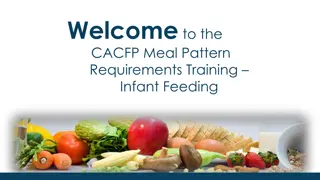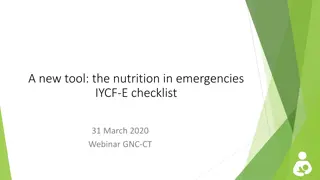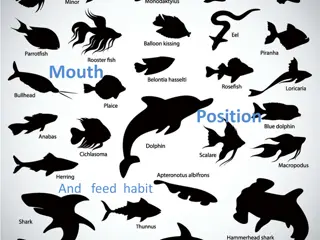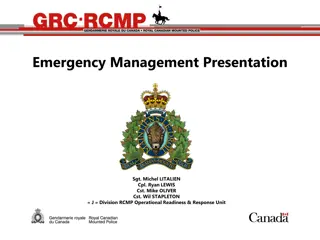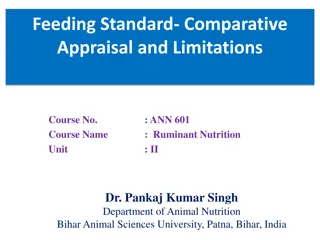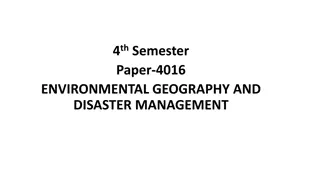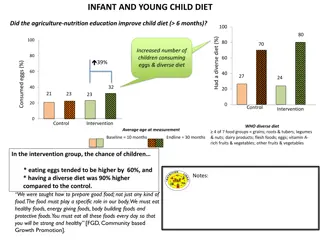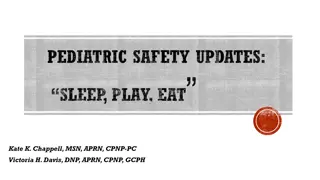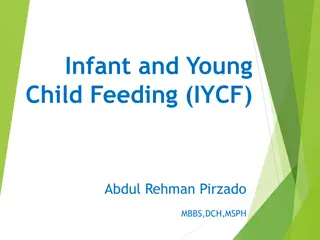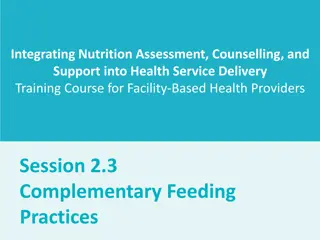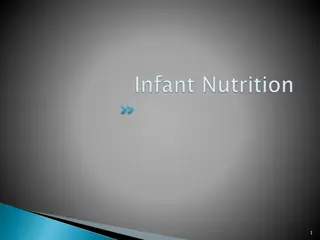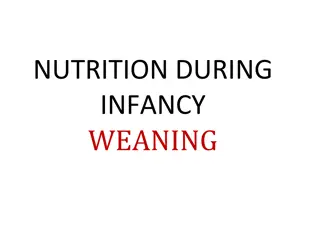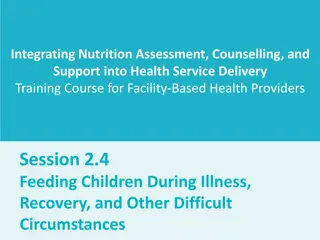Infant and Young Child Feeding in Emergencies: Operational Guidelines
Infant and Young Child Feeding in Emergencies (IYCF-E) focuses on protecting and supporting safe feeding practices for infants and young children during all types of emergencies to reduce mortality and morbidity risks. Key actions include developing policies, training staff, coordinating operations, monitoring and assessing, and promoting optimal feeding practices. The guidelines also address re-lactation for women who have stopped breastfeeding, emphasizing factors affecting re-lactation and support from family, health workers, and the community.
Download Presentation

Please find below an Image/Link to download the presentation.
The content on the website is provided AS IS for your information and personal use only. It may not be sold, licensed, or shared on other websites without obtaining consent from the author. Download presentation by click this link. If you encounter any issues during the download, it is possible that the publisher has removed the file from their server.
E N D
Presentation Transcript
NATIONAL MATERNAL, INFANT, YOUNG CHILD AND ADOLESCENT NUTRITION OPERATIONAL AND PROGRAMMATIC GUIDELINE Infant and young child feeding in Emergencies
Infant Young Child Feeding in Emergencies (IYCF-E) Concerns protection, support of safe and appropriate feeding for infants and young children in all types of emergencies Protection, promotion and support of adequate IYCF practices are crucial to reduce the risk of infant mortality and morbidity in emergencies. An effective IYCF response depends on a strong program prior to the emergency Immediate focus is to do no harm and save the most lives in the shortest time Immediate efforts and resources must concentrate on large scale public health communications to reach the majority with the most relevant IYCF messages
Key IYCF-E actions in emergency preparedness and response Endorse or develop policies Train staff Coordinate operations Assess and monitor Protect, promote and support optimal infant and young child feeding with integrated multi-sector interventions Minimize the risks of artificial feeding
Infant Young Child Feeding in Emergencies (IYCF-E) Cont....... Re-lactation Resumptionof production of breastmilk in a woman who has stopped breastfeeding Women whose production of breastmilk has diminished or those who have breastfed in the past can be supportedto re-lactate Reasons for re-lactation Where breastfeeding was not successfully established afterdelivery. After separationof the mother and infant due to medical reasons Factors that affect re-lactation Infant s age Infant s willingness to suckle. Infant s breastfeeding gap Infants feeding experiences during the gap Reasons related to the infant that led to stopped breastfeeding
Infant Young Child Feeding in Emergencies (IYCF-E) Cont....... Factors related to the infant s mother include; Mother s motivation Conditions of the breasts Mothers previous lactation experience Support from family, health workers and community Ability of the mother to bond with the child Health and nutrition status of the mother
Key Actions to support re-lactation Find out reasons why breastfeeding was interrupted and re-lactation considered Provide information, counselling and practical support while building the mothers confidence for successful relactation Provide information to other family members to ensure they understand and provide the required support at home Support the mother to ensure adequate stimulation of the breast and nipples through the infants suckling, expressing breastmilk or skin to skin contact Put to the breast as often as possible, both day and night and they should suckle on both breasts.
Key Actions to support re-lactation cont Proper position and attachment should be practiced by the mothers to prevent nipple trauma and ensure effective removal of breastmilk Infant is unwilling to breastfeed, the mother should ensure that the infant is not ill and does not have an anatomical problem than needs specialized help Mothers should be encouraged to continue with skin to skin contact and offer the breast as often as possible
Infant Young Child Feeding in Emergencies (IYCF-E) Cont....... Re-lactation Techniques Supplemental Suckling Technique Drop and Drip Technique Gender and Gender Based Violence (GBV) Risk Mitigation Nutrition, gender inequality and gender-based violence are ofteninterrelated Gender-inequitable access to food and services is a form a GBV that can in turn, contribute to other forms of GBV All humanitarian actors, regardless of mandate or sector, have a responsibility to mitigate GBV risk in their work, in keeping with the Centrality of Protection and principle of Do No Harm.(design, implementationand in organizational policies)
Cont............... Public communication, social mobilization and advocacy Importance of breastfeeding, risks of formula feeding and places where breastfeeding women can find support Context-specific information Coordination and partnership Coordinate with other sectors, such as food security, health, WASH and social protection Monitoring, evaluation and knowledge management Establish a monitoring and evaluation system of IYCF interventions in emergencies Define responsibility for each actoron key actions to be monitored and evaluated



